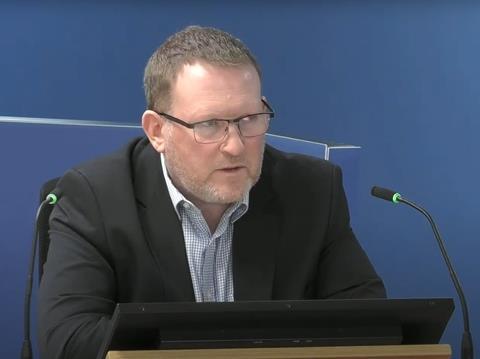Brian Martin failed to warn fire and rescue chief and instead ŌĆślulledŌĆÖ him into false sense of security
The senior civil servant responsible for fire safety guidance knew there was a ŌĆ£clear riskŌĆØ of a major cladding fire three years before Grenfell but failed to warn the governmentŌĆÖs chief fire and rescue advisor.
Brian Martin, who was in charge of fire safety regulations in buildings for nearly 17 years before the Grenfell Tower fire, told the inquiry into the 2017 blaze that he ŌĆ£didnŌĆÖt really knowŌĆØ why he had not warned Peter Holland in a February 2015 email exchange about the dangers posed by the use of combustible ACM panels in the UK.
YesterdayŌĆÖs hearing focused again on an ambiguous passage in the fire safety guidance that was intended to ban the use of ACM.
The passage, added in a 2006 revision of the guidance written by Martin and his civil service team, stated that ŌĆ£fillerŌĆØ materials in cladding systems needed to obtain the tough fire standard of limited combustibility.
The phrase was a last-minute addition that was never subjected to consultation with the industry and lacked a clear definition.

It was also contained in a passage titled ŌĆ£Insulation Materials/ProductsŌĆØ, leading many in the industry to believe that the word only referred to insulation products and not to cladding panels.
Martin accepted that he had been aware from July 2014 that parts of the construction industry had been misinterpreting the passage after he was warned at a meeting with fire safety experts organised by the Centre for Windows and Cladding Technology.
But he had not shared this with Holland, who had emailed Martin following an ACM fire at the Torch Tower in Dubai, and accepted he had instead ŌĆ£lulledŌĆØ Knight into a ŌĆ£false sense of securityŌĆØ about the risk of a similar fire occurring in the UK.
Martin told Holland that there were ŌĆ£provisions in the building regulations designed to prevent this kind of problem, so this shouldnŌĆÖt be a problem in the UKŌĆØ, adding: ŌĆ£There are, of course, no guaranteesŌĆØ.
Counsel to the inquiry Richard Millett asked: ŌĆ£You knew by this point that the guidanceŌĆ” was not being correctly understood in the sense you intended it by at least some of its intended audience; yes? YouŌĆÖd known that from July.ŌĆØ
ŌĆ£Yes,ŌĆØ replied Martin.
ŌĆ£And that therefore you knew that there was a clear risk that the guidance couldnŌĆÖt be applied correctlyŌĆ” by at least that group of readers; yes?ŌĆØ Millett asked.
ŌĆ£YesŌĆØ, Martin replied.
ŌĆ£And that therefore there was a clear risk that the fire, just like that at The Torch building, might well not be prevented, because people in the industry, for some years beforehand, had not understood [the guidance] in the way youŌĆÖd intended it?ŌĆØ Millett asked.
Martin said: ŌĆ£I think thatŌĆÖs a fair point. I think at the time it was one of a number of issues that could have arisen, I guess. I donŌĆÖt think IŌĆÖd have treated it differently.ŌĆØ
Asked if he had not considered alerting Holland to the ŌĆ£widespread lack of consensusŌĆØ about the passage on cladding materials, Martin said ŌĆ£I didnŌĆÖt at the time, noŌĆØ.
Asked why, he said: ŌĆ£I donŌĆÖt really knowŌĆØ, adding HollandŌĆÖs role had been reduced. ŌĆ£When Mr Holland took over the job, the remit had become quite narrow, and maybe thatŌĆÖs what I had in mind, I donŌĆÖt knowŌĆØ.
Millett suggested that Martin had given his reassurances to Holland with his ŌĆ£fingers crossedŌĆØ, knowing that there was ŌĆ£at least a significant proportionŌĆØ of the industry which had been misinterpreting the phrase ŌĆ£fillerŌĆØ.
Martin said: ŌĆ£I didnŌĆÖt say it couldnŌĆÖt happen, I said it shouldnŌĆÖt happen, and I said that there were no guaranteesŌĆØ.
ŌĆ£ThatŌĆÖs hardly sending the message, is it, to Peter Holland that there is a sizeable chunk of the building industry who does not think or did not think for some years that a core of a composite rainscreen panel needed to be of limited combustibility? Is it?ŌĆØ Millett asked.
Martin accepted that it ŌĆ£would have been better toŌĆ” bring that more to the front than perhaps I did at the time.ŌĆØ
ŌĆ£But itŌĆÖs worse, isnŌĆÖt it?ŌĆØ Millett said. ŌĆ£Because by not doing that, do you accept that you lulled him, and others reading this, into a false sense of security?ŌĆØ
ŌĆ£I think thatŌĆÖs perhaps a fair accusation or criticism,ŌĆØ Martin replied.
The inquiry has already heard that Martin had agreed at the meeting with the CWCT to draft a ŌĆ£frequently asked questionsŌĆØ (FAQ) document clarifying the meaning of the word ŌĆ£fillerŌĆØ and to publish it on the governmentŌĆÖs website.
The FAQ was never published, with Martin telling a hearing earlier this week that he had ŌĆ£forgottenŌĆØ about the request because it had been a ŌĆ£busy timeŌĆØ.
He has also admitted that he ŌĆ£completely underestimatedŌĆØ the hazard posed by ACM, adding ŌĆ£I think if IŌĆÖd fully understood it, I may have put more time into this issueŌĆØ.
ACM, which was used on Grenfell Tower and has been found by the inquiry to be the ŌĆ£primary causeŌĆØ of the rapid spread of flame which caused the deaths of 72 people, was only explicitly banned by the government in December 2018, a year and a half after the fire.
The inquiry continues.


























